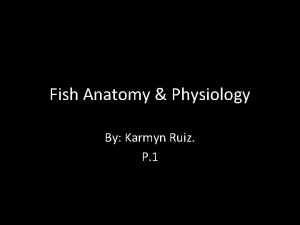FISH ANATOMY AND PHYSIOLOGY ANATOMY Most fish all











- Slides: 11

FISH ANATOMY AND PHYSIOLOGY

ANATOMY Most fish all around the world have the same composition of organs, but every fish has different behaviors. Most fish typically have the main organs; which include fins, a complete digestive system, reproductive system, and a nervous system. There are some fish that have unique organs as well that give them special abilities, like tarpon and anabantoidei. Another fish with unique organs are anglerfish as well.

FINS • Dorsal fin- helps protect the fish against rolling, and assists in sudden turns and stopping • Caudal fin- (tail fin) used for propulsion, forward movement • Pectoral fin- on each side, used for balancing and braking • Pelvic fin- attached to pelvic girdle, helps control direction of movement • Adipose fin- soft and fleshy located behind dorsal • Anal fin- located on the ventral surface behind anus, used for stability while swimming

DIGESTIVE SYSTEM 1) Mouth- opening to allow food to enter 2) Pharynx- in some species, located inside are pharyngeal jaws 3) Esophagus- tube that connects the pharynx to the stomach (Passage way for food) 4) Gizzard- breaks down the whole food into smaller pieces and inserts enzymes 5) Stomach- varying in shape, has pepsins and Pyloric Caeca 6) Intestine- long thin, muscular , double layered tube; last stage of digestion and absorption of nutrients 7) Rectum (Anus)- end of intestine, which waste passes out the body

REPRODUCTIVE SYSTEM • Organs include testes , ovaries, gonads, and genital papilla • Testes – male organ; contains seminiferous tules that hold germ cells and develops them to sperm cells. • Ovaries- can hold millions of eggs, the eggs come from germinal epithelium; has lymph filled space for the Oviduct to open for the eggs to shed • Eggs- they are jelly like and most eggs are fertilized externally • Genital papilla – fleshy tube behind the anus, where the eggs are released; shape of it can determine the sex of the fish

NERVOUS SYSTEM • Most species have a central nervous system including a brain and spinal cord • Tarpon for example has a brain divided in 3 sections ; forebrain, midbrain, and hindbrain • Forebrain- responsible for fish's sense of smell • Midbrain- responsible for vision, learning and motor responses • Hindbrain- responsible for coordination in movement

CARDIOVASCULAR SYSTEM • Consists of three main parts ; a heart, blood, and blood vessels • Most fish have a one "closed circuit" system, the circuit goes from the heart to the lungs, then throughout the body • Veins carry carbon dioxide and waste products away from the cells, back to the heart • Plasma- part of the blood to suspend the other components of the blood with in it, including food for the cells hormones, and waste products from the cells to the liver and kidneys • Red blood cells to transport oxygen to the cells in the fish and transport carbon dioxide away from the cells. Red blood cells are high in hemoglobin which is high in iron. The iron binds with the oxygen for transportation throughout the vessels

TARPON (Image of silver King, another name for tarpon)

TARPON'S ABILITIES • Tarpon are able to breathe air due to their swim bladder • Their eyes are very large , and also have a layer of cells that act much like a strip of reflective tape at the back of the eye, which helps their vision at night and day spotting prey • Tarpon also have the ability to jump

VIDEO OF TARPON IN THE AIR • http: //youtu. be/2 ki. JJW 4 a 82 U

BIBLIOGRAPHY • http: //www. simplydiscus. com/library/biology/anatomy/circulatory_system. shtml • https: //en. m. wikipedia. org/wiki/Fish_anatomy • http: //www. saltwatersportsman. com/species/fish-species/science-behind-tarpon • http: //www. sportfishingmag. com/species/tarpon-fishing-grounds-alabama • https: //en. m. wikipedia. org/wiki/Tarpon#Physical_characteristics
 One fish two fish red fish blue fish ride
One fish two fish red fish blue fish ride Fish anatomy and physiology
Fish anatomy and physiology Fish anatomy and physiology
Fish anatomy and physiology Twofish and blowfish
Twofish and blowfish Scale types fish
Scale types fish Respiratory physiology
Respiratory physiology Tattoo anatomy and physiology
Tattoo anatomy and physiology Science olympiad anatomy and physiology
Science olympiad anatomy and physiology External parts of a leaf
External parts of a leaf Bone metabolism
Bone metabolism Gastric ulcer differential diagnosis
Gastric ulcer differential diagnosis Segmental anatomy of the liver
Segmental anatomy of the liver




















